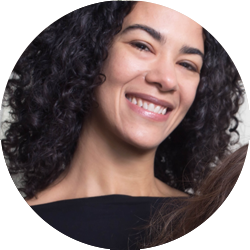Last week my 3-year-old fell off the swing and face-planted on the ground. She laid there for a second, and I got down next to her. She wasn’t crying, so I said, “What do you see?” “My necklace,” she replied, and she got rather interested in checking out its detail. “Interesting blades of grass there, too,” I offered, brushing my finger across them. “Yeah,” she said.
And then she was over it. “Again the swing!”
It was a welcome change. Over the past year or so, I think we’d gotten in the habit of making too big a deal when she falls down, and she’d begun crying dramatically even though she wasn’t really hurt. So we’re getting back to the more nonchalant reaction we used to have.
It’s not dismissive (“Oh, you’re OK”) or harsh (“Quit that crying”). Kids who get those responses to big emotions tend to be, studies show, less socially well-adjusted later. They don’t get practice dealing with emotions, so they don’t build emotional regulation skills to the same degree.
But it’s not fawning, either (“Ohhh, sweetie! Come heeere. Mama will kiss it!”). It’s just acknowledging what happened, giving comfort as needed, and moving on.
A reader asked me about this, and it was a good reminder to me, too.
Q: My son is 12 months old. He is learning to walk and he cries loudly after falling down. How can I comfort my son and encourage him with process praise?
A: Here are four ways to handle minor falls:
1. Check your own reaction. If you’re anxious, rushing over with a look that says, “Oh no!,” he is more likely to be upset by falling. If you are very casual (“Oops, you tripped, huh?”) and talking in an even tone of voice, then your child is more likely to stay calm. Little ones often look to us for what their reaction should be (called social referencing).
The balance we’re trying to strike is “I’m here for you, but I also trust that you can do this,” as Tovah Klein, director of the Barnard Center for Toddler Development, told Slate.
I like to think of a toddler climbing on something: our hands are nearby, ready for a fall, but we’re no longer gripping the back of their pants. We can have the same balanced approach with emotions.
2. Show him a different response. One option is “Brush it off.” When he falls, you’d say calmly, “Let’s brush it off” and do a hand gesture of brushing your hands together. Take his hands and brush them together. “When we fall, we can brush it off.”
3. If he’s upset, acknowledge his emotion. “That was a little surprising, huh! Yeah. Need a kiss?” Then move forward: encourage him to try again.
4. If he does try again, that’s when you would acknowledge his process: “You fell down, but you stood back up!” “You’re trying again!” “You took a step!” (See more on why and how in my video course on raising confident kids with a growth mindset.) An enthusiastic facial expression and a touch both help cement your encouragement.
If he doesn’t try again, help him leave the door open: “You’re not ready yet. You’ll try again when you’re ready.” That’s staying on your child’s side — one thing we do in Language of Listening, the model I teach.
Written by
Tracy Cutchlow
Tracy is the author of the international bestseller Zero to Five: 70 Essential Parenting Tips Based on Science, a public speaker, and a creator of places to speak and be heard. Sign up for her newsletter here.


Tracy, so glad you wrote this! Here’s a story that supports your point.
My husband and I were at a picnic a while ago and a little guy about age 2 fell off of the picnic table bench and started crying. When the parent said, “Oh, you’re OK,” and the child clearly didn’t think, he ran to another person and another and another, who all said pretty much the same thing. Still crying, he tried my husband (who he didn’t even know). When my husband (who was calm) matched the child’s feelings and said, “Oh no! You fell, and you didn’t like that. That scared you!” he stopped crying, turned around and ran off to play. Most of the time, kids just want to be heard!
What a great story, Sandy! Thank you so much for sharing it.